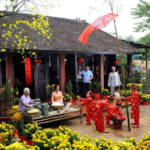Rosewood is an exotic and valuable wood in Vietnam, known for its economic and aesthetic significance. This rare wood is used to craft a variety of items, and today, we will delve into the world of rosewood, exploring its characteristics, uses, and cultivation.
1 What is Rosewood?
Origin and Significance of Rosewood
Rosewood, or Dalbergia Oliveri Gamble, is a naturally occurring wood with high economic and aesthetic value. It is a rare and precious wood in Vietnam, known for its dense and durable nature.
The beauty of rosewood lies in its intricate grain patterns and vibrant colors, which remain intact for years. Its superior strength, stunning appearance, and longevity make it a highly valued wood, setting it apart from common varieties.
 Rosewood
Rosewood
Characteristics and Classification of Rosewood
At first glance, rosewood may resemble redwood or scented wood, but its distinct feature lies in the consistent and dense grain pattern. The white sapwood of rosewood creates a captivating contrast, making it ideal for crafting exquisite furniture and artisanal crafts.
Belonging to the legume family, rosewood is predominantly found in the Central Highlands and Southern regions of Vietnam, as well as imported from countries like South Africa, Laos, and Cambodia. Rosewood trees typically have large trunks, an umbrella-shaped canopy, and can grow up to 20-25 meters tall with a trunk diameter of 0.5-0.6 meters.
Rosewood is characterized by its slow growth rate, and the number of trees is limited. During the dry season, the trees shed their leaves, only to quickly sprout new growth.
Based on color and external characteristics, rosewood can be categorized into two main types: red rosewood and black rosewood.
Red Rosewood
Red rosewood, distinguished by its bright grain, is a rare and economically valuable wood. The older and larger the tree, the more prized it becomes. Red rosewood is known for its hardness, durability, and subtle fragrance, making it a favorite among wood enthusiasts.
 Red Rosewood
Red Rosewood
Black Rosewood
Black rosewood, as the name suggests, features a dark grain pattern. While it may be considered less valuable economically than its red counterpart, black rosewood excels in its utility. Commonly used for crafting living room furniture and cabinets, it also possesses insect-repelling properties.
 Black Rosewood
Black Rosewood
2 Benefits and Uses of Rosewood
The beauty and durability of rosewood make it ideal for furniture production and artisanal crafts.
 Benefits and Uses of Rosewood
Benefits and Uses of Rosewood
Rosewood is often chosen for crafting furniture such as chairs, beds, wardrobes, and kitchen cabinets. Its ability to withstand weight and its smooth grain make it perfect for creating intricately carved bed frames, adding a touch of luxury to any home.
Advantages
The standout feature of rosewood is its consistent and beautiful grain pattern. The tight grain and strong fibers of the wood protect it from environmental damage. Additionally, rosewood boasts excellent durability, resistance to termites, minimal warping, a glossy surface, and a fragrance that repels insects. Its aesthetic appeal lies in its vibrant colors and intricate patterns.
 Advantages of Rosewood
Advantages of Rosewood
Disadvantages
As a rare wood in Vietnam, rosewood products tend to be expensive. The cost of Laos rosewood, African rosewood, and Vietnamese rosewood is comparable to that of redwood, ranging from 50 to 70 million VND per cubic meter. Additionally, rosewood products are susceptible to counterfeiting due to their resemblance to other types of wood in terms of color and structure.
 Disadvantages of Rosewood
Disadvantages of Rosewood
3 Cultivation and Care of Rosewood Trees
Growing Rosewood Trees at Home
To grow a rosewood tree, select a healthy seedling, free from pests and diseases. Choose a suitable planting site, dig a hole, and place the seedling inside. Fill the hole with soil and water the tree sufficiently to maintain moisture.
 Cultivation and Care of Rosewood Trees
Cultivation and Care of Rosewood Trees
Caring for Rosewood Trees
- Soil: Choose fertile, well-drained soil.
- Watering: Water the tree three times a day initially, reducing to twice a day as it matures. Avoid watering too close to the trunk to prevent waterlogging and root rot.
- Fertilizer: Apply nitrogen, phosphorus, or NPK fertilizers during the tree’s growth phase.
Notes on Cultivation and Care
- Before planting, apply root-stimulating drugs such as N3M, Bimix super root, or Roots 2 to enhance root development.
- When planting from seeds, purchase high-quality seeds from reputable stores to ensure a higher germination rate and healthier trees.
- Alternatively, you can collect seeds from ripe rosewood fruits. Choose healthy, plump fruits with firm seeds. However, this method typically results in a lower germination rate and less predictable tree quality.
4 5 Captivating Images of Rosewood Trees
 The Beauty of Rosewood Trees
The Beauty of Rosewood Trees
 Rosewood, or Dalbergia Oliveri Gamble
Rosewood, or Dalbergia Oliveri Gamble
 Predominantly found in the Central Highlands and Southern regions of Vietnam
Predominantly found in the Central Highlands and Southern regions of Vietnam
 Rosewood’s exquisite grain and color
Rosewood’s exquisite grain and color
 Rosewood’s slow growth rate
Rosewood’s slow growth rate
We hope you found this information about rosewood trees insightful and useful.
Explore 12 Amazing Destinations for Biking Trips
Unlock Vietnam in a brand new way with an exciting biking tour! Discover the stunning beauty of the country with Dien May XANH’s top 12 must-see destinations. From sweeping plains to clear blue beaches and mountainous vistas – experience all the sights with your own personal cycling tour. Find your ideal route and set out for an adventure today!







































